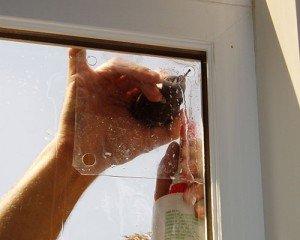As their old windows become more shoddy and less energy efficient, most homeowners are faced with the question whether they should replace their windows or try to repair them.
It is true that with most problems, there are ways to extend a window’s life with repair. However, you have to understand that any repair may improve a window’s performance, but not necessarily restore it back to the original levels.
A common problem windows face as they begin to age is sealed unit failure. A sealed unit combines the multiple panes of a window into one, sealing the moisture out. Older sealed units are usually filled with air, while modern options have gas fills for improved energy efficiency. When a sealed unit fails the air can travel in and out of the space between panes, making your windows less efficient. This is usually manifested by moisture or condensation on the inside of the glass.
Good condensation vs. bad condensation
A lot of the time homeowners see condensation or moisture on the glass of their windows and think that the sealed unit has failed. But in reality, the more efficient a window is, the more likely it is to create condensation in colder weather, as the difference between the outside and inside temperature is more severe. So how do you tell condensation from sealed unit failure? Simple. If the condensation is on the outer pane of the sealed unit, this is absolutely normal. You should be able to wipe this kind of condensation off. If the condensation is on the inside of the sealed unit, and you can’t wipe it off, that means air is allowed to penetrate the unit, and the seal has failed.
A sealed unit is the most technologically complicated part of your replacement windows, so when sealed units fail, the energy performance of your windows drops significantly as well. One of the popular aftermarket repairs for failed insulated glass units is the installation of a fog out system.
When fog out is installed, two small holes are drilled in the outer glass pane. A defogger vent is then put in on the hole. As the air heats up and cools down it doesn’t simply form as moisture on the glass surface, but rather evaporates through the defogger vent, leaving the inside of your window more dry and at a more balanced temperature.

Is fog-out a good repair option for failed sealed units?
Although most fog out companies will assure that the repair restores a window’s R value back the original, it is important to understand what exactly that means.
R-value is a measure of conductance and resistance in any product. A window with high conductance will lose heat quickly. Although the R value and U-factor are similar measurements, the window industry relies mostly on the U-factor to assess a window’s performance. The U-factor takes into account more than conductance. It also is affected by the airflow (convection) around the window and the emissivity (radiated or reflected heat) of the glass. So while your window with fog out won’t overheat in the summer, and lose less heat in the winter, overall it will most likely not perform as well as it did when the insulated glass unit seal was intact.
A fog out repair does not fix the seal of a window, of a window it merely fixes the issue with moisture fogging it up. This fix is especially not worth it if your sealed units came with a gas fill, as after it failed the unit probably leaked the gas out.
What’s the best solution for failed sealed units? Unfortunately the only true way to get the most out of a broken sealed unit is to replace it. Obviously that is a more expensive option, that may not be right for some homeowners, but only a sealed unit replacement guarantees maximum performance of your windows.
When you are shopping for new windows, try to avoid seal unit failure problems from the start. Look for companies who’s windows are ENERGY STAR rated and/or CSA certified. Sealed unit warranty should also be a big factor when you are deciding on a local window company. All companies offer insulated glass unit warranty, ranging from 10-20 years. If a company’s windows are ENERGY STAR rated that number is going to be closer to the twenty-year mark. And while some companies are quick to make the warranty claim in order to sell you their windows, not all of them will still be there for the whole term of your warranty. Also the labour warranty on sealed unit failure differs from company to company. Because it is considered skilled labour, some companies don’t offer actually replacing the sealed unit as part of their warranty.
At Ecoline Windows, our sealed units are some of the best performing on the Canadian market. All our vinyl windows are custom made for your order, are ENERGY STAR rated and CSA approved. We offer a twenty five year warranty on our sealed units, and five years labour on glass unit replacement.
Check out:
Why Getting New Windows is Better Than a Sealed Unit
Broken Sealed Unit? Why A New Window May Cost You Less Than Repair
Find Out The Cost of Replacement Windows
